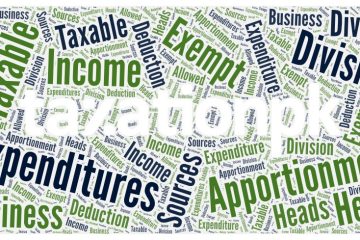Partnership firms are a popular business structure, but navigating their taxation can be tricky. One common area of confusion, often leading to notices and penalties from the Income Tax Department, revolves around the treatment of partner’s salaries, commissions, bonuses, and incentives. Many businesses incorrectly deduct these payments as expenses, leading to understated profits and potential tax liabilities.
This article aims to demystify this crucial aspect of partnership taxation, focusing on Section 21 of the Income Tax. We’ll use a practical example to illustrate the correct approach and help you avoid costly errors.
The Common Pitfall: Deducting Partner Remuneration as Expenses
Imagine a partnership firm finalizing its accounts. It seems logical to treat partner salaries and commissions just like employee salaries – as business expenses that reduce taxable profit. However, this is where many businesses stumble. Section 21 clearly states that salaries, commissions, incentives, and bonuses paid to partners are not deductible expenses for the partnership firm.
Why is this the case?
The rationale behind this rule is simple: partners are essentially owners of the business, not employees. Payments made to partners are considered an appropriation of profit, not an expense incurred to earn that profit. Allowing deduction of partner remuneration would artificially reduce the partnership’s taxable income and create a tax loophole.
Let’s Understand with an Example:
Consider a partnership firm, “ABC & Co.”, finalizing its accounts as of June 30th. Here’s a simplified financial picture:
- Sales: Rs 15,00,000
- Cost of Goods Sold (Steel): Rs 8,00,00,000
- Gross Profit (GP): Rs 7,00,00,000
- Salary to Partner A: Rs 1,00,000
- Commission to Partner B: Rs 50,000
- Depreciation (Accounting & Tax): Rs 50,000
- Profit as per Books (before partner remuneration & depreciation adjustment): Rs 5,00,000 (This seems to be a figure provided in the original text, and is assumed to be profit before considering partner salaries, commission, and adjustments required for tax purposes. Logically, Rs 7 Lakh GP – Rs 8 Lakh Cost should be a loss, but we will proceed with the Rs 5 Lakh profit figure as given in the example for illustration).
If ABC & Co. incorrectly treats Partner A’s salary and Partner B’s commission as deductible expenses in their profit and loss account, their taxable profit would be artificially reduced.
The Correct Approach – Section 21 in Action:
Section 21 mandates that partner’s remuneration (salary, commission, etc.) must be added back to the profit as per the books for tax computation purposes. Similarly, any depreciation debited in the books, if different from tax depreciation, needs adjustment.
Let’s apply the correct approach to ABC & Co.’s example:
- Profit as per Books (before partner remuneration & adjustments): Rs 5,00,000
- Add back: Salary to Partner A: Rs 1,00,000
- Add back: Commission to Partner B: Rs 50,000
- Add back: Accounting Depreciation (if higher than tax depreciation) – In this case, both are Rs 50,000, so no net adjustment needed for depreciation in this step. However, we do need to consider tax depreciation later as a deduction.
- Adjusted Profit (before tax depreciation): Rs 7,00,000
- Deduct: Tax Depreciation (as per Income Tax Rules): Let’s assume Tax Depreciation is Rs 40,000 (as mentioned later in the text as an example).
- Taxable Income of the Partnership Firm: Rs 6,60,000 (Corrected from Rs 7,00,000 – Rs 40,000 = Rs 6,60,000. The original text incorrectly states Rs 7,06,000, which is likely a calculation error)
Tax on Partnership Firm’s Income and Distribution to Partners:
The taxable income of Rs 6,60,000 will be taxed at the applicable partnership firm tax rates. Let’s assume for simplicity, a flat rate, though slab rates exist. The tax amount is calculated on this Rs 6,60,000.
After paying taxes, the distributable profit is then divided between Partner A and Partner B as per their agreed profit-sharing ratio (in this example, assumed to be 50:50).
Partner’s Income in their Individual Returns:
It’s crucial to understand that partners are taxed on their income from the partnership, but in a different way:
- Share of Partnership Profit: Each partner will include their share of the distributable profit from the partnership firm in their individual income tax returns. In our example, if the taxable income is Rs 6,60,000, and assuming Rs 20,000 is tax (example figure, actual tax needs proper rate application), distributable profit becomes Rs 6,40,000 (Rs 6,60,000 – Rs 20,000). Each partner’s share (50%) would be Rs 3,20,000.
- Partner’s Remuneration (Salary & Commission): Importantly, even though the salary and commission were added back for the partnership’s tax calculation, partners are also taxed on the salary and commission they receive from the firm in their individual returns. This remuneration is essentially considered a distribution of profit and is taxable in the partner’s hands.
Therefore, in Mr. A’s individual return, his income would be:
- Share of Profit: Rs 3,20,000
- Salary from Partnership: Rs 1,00,000
- Total Income for Mr. A: Rs 4,20,000
In Mr. B’s individual return, his income would be:
- Share of Profit: Rs 3,20,000
- Commission from Partnership: Rs 50,000
- Total Income for Mr. B: Rs 3,70,000
Key Takeaways & Avoiding Penalties:
- Partner remuneration (salary, commission, etc.) is NOT deductible as an expense for the partnership firm. Always add it back to the profit as per books for tax computation.
- Taxable income of the partnership firm is calculated before deducting partner remuneration but after considering tax depreciation.
- Partners are taxed on their share of the partnership’s distributable profit and on any salary, commission, etc., received from the firm.
- Incorrectly deducting partner remuneration leads to understated partnership profits and potential penalties from the Income Tax Department.
Understanding the details of Section 21 and the correct treatment of partner remuneration is crucial for accurate partnership taxation. By avoiding the common mistake of deducting these payments as expenses, you can ensure compliance, prevent penalties, and maintain accurate financial records.




